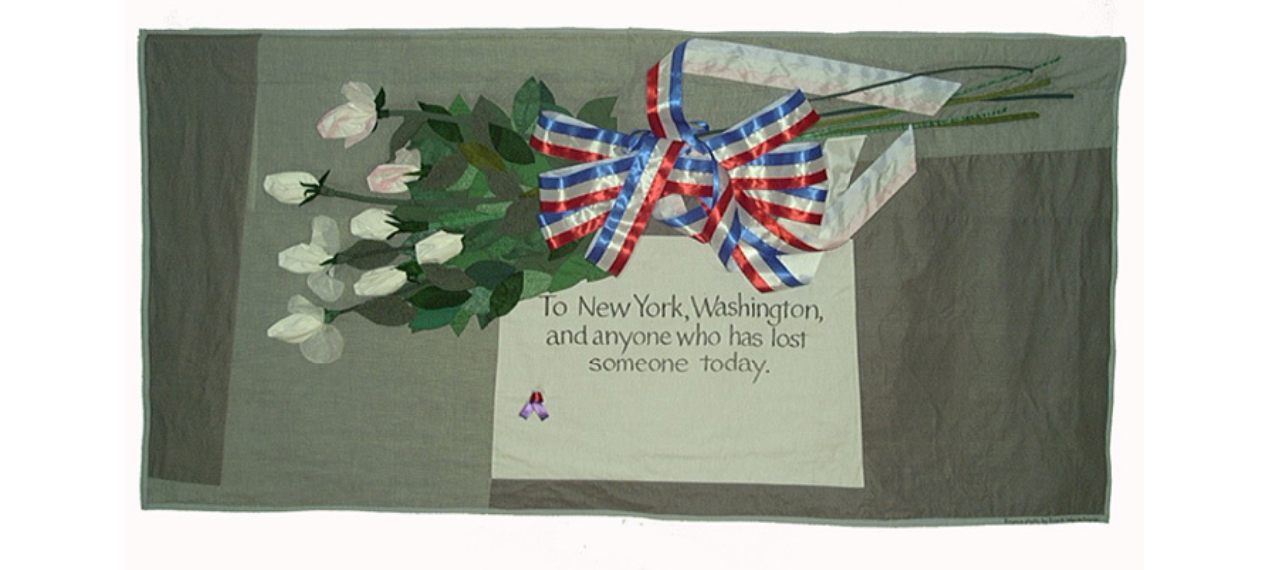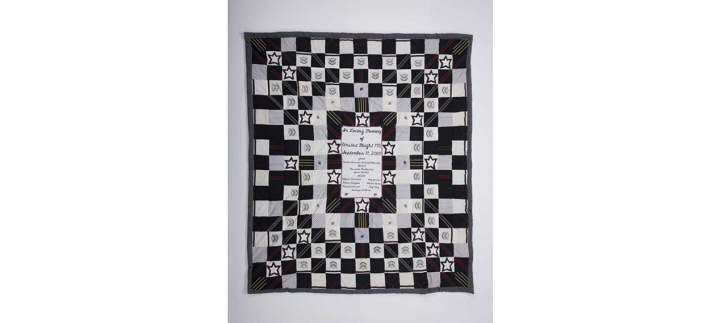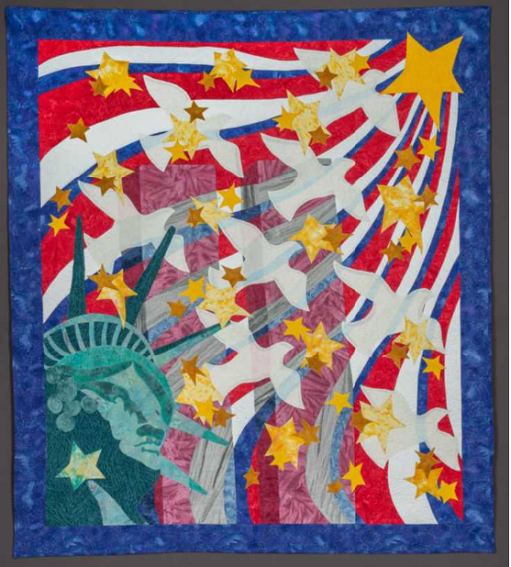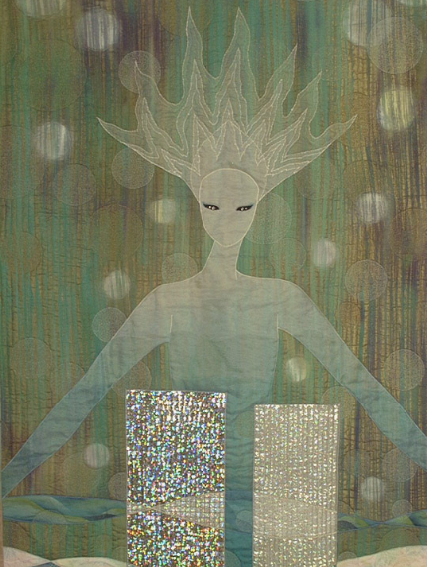Make a donation to the museum
Quilting After 9/11
Quilting After 9/11

Overwhelmed by grief, fear, and anger in the wake of 9/11, people around the world searched for ways to help. For those unable to participate in the rescue and recovery efforts at the attack sites, quilt making became an option for offering practical, creative, and symbolic consolation to, and support for 9/11 family members, responders, survivors, and others who were directly affected by the attacks.
“I didn't know what to do, think, even feel,” recalled Sarah Roberts, the maker of a quilt featuring a bouquet of white roses tied with red, white, and blue ribbon and titled To New York, Washington and anyone who lost someone today. “The only thing I felt entirely sure of was sadness, and compassion for those who lost their lives and loved ones.”
“I wanted to put flowers on a sidewalk memorial,” said Roberts of her quilt, which is one of more than 150 in the 9/11 Memorial Museum’s collection. “To remember the dead and comfort the living.”

To New York, Washington and anyone who lost someone today. Collection 9/11 Memorial Museum, Gift of Drunell Levinson and of the contributors to the September 11 Quilts Memorial Exhibition. Photo by Drunell Levinson.
Highly skilled fabric artists and talented novices inexperienced with needle and thread alike turned to making quilts as a way of expressing condolence, patriotism, and solidarity. As in prior times of national upheaval, including during the Civil War era and AIDS epidemic, designers of 9/11-inspired quilts drew upon patriotic motifs, religious symbols, victims’ names and faces, and images that became emblematic of the attacks and their aftermath.
Left: Spirits Rising II (2001). Collection 9/11 Memorial Museum, Gift of Betsy Shannon, Minneapolis, MN. Photo by Michael Hnatov. Center: Broken Hearted. Collection 9/11 Memorial Museum, Gift of Drunell Levinson and of the contributors to the September 11 Quilts Memorial Exhibition. Photo by Drunell Levinson. Right: Fragile. Collection 9/11 Memorial Museum, Gift of Drunell Levinson and of the contributors to the September 11 Quilts Memorial Exhibition. Photo by Drunell Levinson.
Quilt makers also turned to the architecture of the Twin Towers and the Pentagon, and to the day’s memorable blue sky. Some quilts in the collection depict angels or abstract protective beings comforting all who were lost. For 9/11 family members who made quilts in remembrance of loved ones, and those who received such memorial gestures from strangers, the quilts offered comfort, healing, and warmth.

Remembering Our Heroes United Airlines Flight 175 Memorial Quilt. Collection 9/11 Memorial Museum, Gift of the Association of Flight Attendants - CWA, AFL-CIO members Andrea Jones, Patrice Richardson, Jennifer Workman Golden and other United Airlines colleagues. Photo by Matt Flynn.
Remembering Our Heroes United Airlines Flight 175 Memorial Quilt is one of eight quilts made by colleagues of the seven crew members killed aboard the Boston-departed, hijacked Flight 175. Fabricated from bits and pieces of airline uniforms, each of the first seven quilts honors and memorializes a single victim; the quilt donated to the Museum memorializes all of the flight professionals lost when Flight 175 crashed into the South Tower.
Today we are witnessing a new wave of compassion and support for responders and victims of another devasting tragedy. Some 9/11 quilters have already turned their sewing skills to the needs of COVID-19 frontline responders. Since mid-March, Sarah Roberts, for example, has sewed 444 face masks from fabric she had collected over the years and sent them to Chestnut Hill Hospital in Philadelphia. Not surprisingly, Roberts is saving fabric scraps from her face mask project in anticipation of making a quilt reflecting her thoughts and feelings about the current pandemic. It’s likely that she will not be alone in turning to the centuries-old medium of the quilt as a gesture of condolence to the families of those who have died from the disease and gratitude to responders and other essential workers. Quilts included in the 9/11 Memorial Museum’s permanent collection may offer inspiration to a new generation of quilters. Their message of comfort and compassion is timeless. A selection of illustrative images of those quilts may be found on Inside the Collection.
By Amy Weinstein, Senior Curator of Oral History & Vice President of Collections, 9/11 Memorial & Museum
Previous Post
With Your Support the 9/11 Memorial Will Reopen on Independence Day

The National September 11 Memorial & Museum is launching a major fundraising campaign to reopen the Memorial on Saturday, July 4.
Next Post
Almost 20 Years After 9/11, “The Fathers’ Eight” Stand as a Trio of Dads

The Band of Dads spent months at Ground Zero searching for their missing sons who had followed them into the uniformed rescue services.


